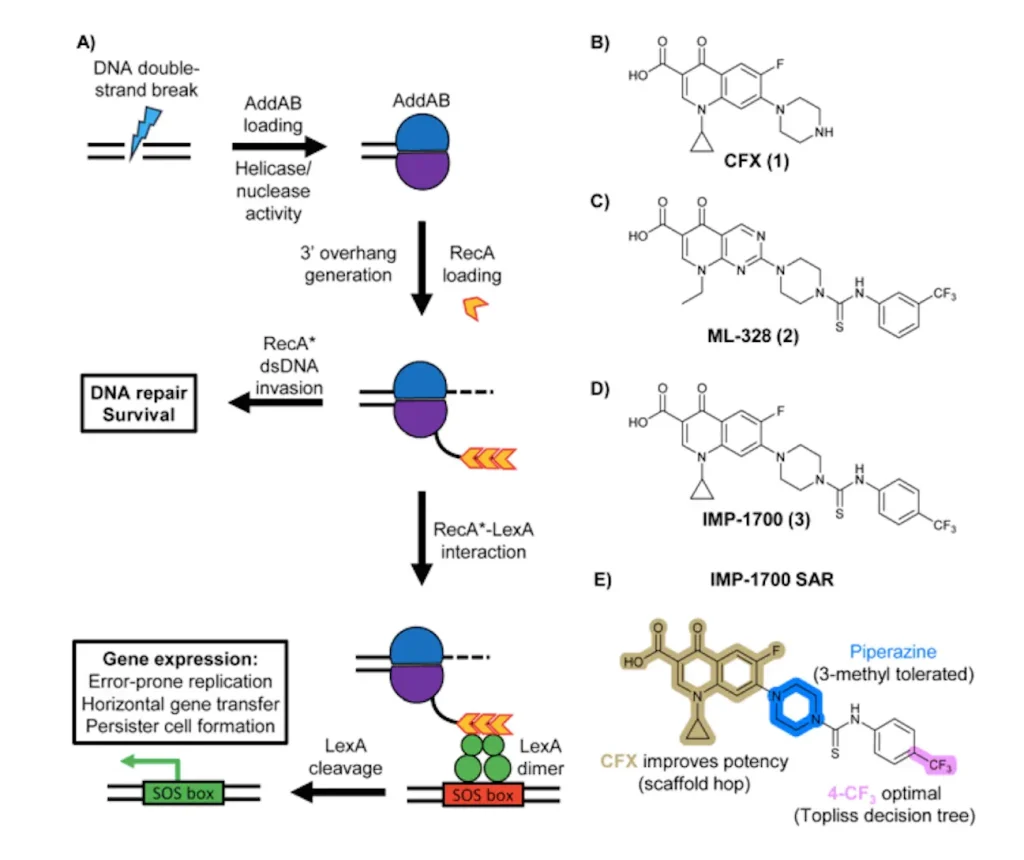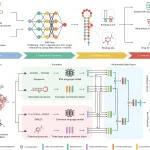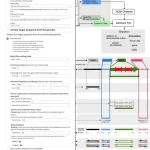Antibiotic resistance is one of the most pressing challenges in modern medicine. As bacteria evolve to withstand our best treatments, once-manageable infections are becoming increasingly difficult, if not impossible, to treat. Among the most notorious of these resistant bacteria are those that resist quinolone antibiotics, a critical class used to treat a variety of infections.
According to the researchers, this study is the first to provide a systematic quantitative analysis of the structure-activity relationship of the IMP-1700 scaffold, and they have successfully developed OXF-077 as the most potent analog. Therefore, OXF-077 inhibits the mutagenic SOS response and decreases ciprofloxacin resistance in methicillin-resistant Staphylococcus aureus (MRSA), proving that the chemicals with anti-SOS activities could be used in combating antimicrobial resistance (AMR) in the future and approving the role of OXF-077 as a tool to develop further.
Understanding the SOS response
SOS response is another defense strategy used in bacteria; for instance, DNA repair is initiated when a bacteria’s DNA is damaged. It is a set of biological functions undertaken by cells that help to resolve DNA damage and preserve the integrity of chromosomes. SOS response also contributes to the development of mutation, following which bacteria are believed to have adapted to some of the stressful conditions and can thrive in some of the most adverse environments. Hence, by focusing on and studying the SOS response, scientists also look forward to designing effective approaches to managing antimicrobial resistance, as well as maintaining the strength of antibiotics.
The Role of Quinolones
Quinolones are a group of drugs with antimicrobial activity based on the inhibition of bacterial DNA gyrase and topoisomerase IV, which are critical enzymes involved in DNA replication and transformation. The above quinolone antimicrobial agents impede bacterial DNA synthesis by restraining these enzymes, thus causing the death of the bacterial cell. Fluoroquinolones are commonly used to treat many bacterial diseases, while opposition to the use of quinolones has been a major concern due to resistance. Knowledge of how quinolones operate and efforts to promote the identification of strategies to counteract the resistance of the bacteria towards these agents are essential in combating antimicrobial resistance.
A Novel Approach: Inhibiting the SOS Response
Some of these strategies related to bacteria include inhibiting the SOS response in bacteria, which seems to be a smarter way of handling antimicrobial resistance. Thus, seeking to inhibit the DNA repair and mutagenesis mechanisms, the agents can block the paths along which bacteria adapt to antibiotic treatment. This strategy is designed to make the process of evolution slower and to increase the effectiveness of the known antimicrobial drugs. Some potential studies involving SOS response inhibitors in the form of compounds, including OXF-077, can provide valuable information for developing new approaches to confronting the expanding issue of antimicrobial resistance.

Recent Breakthroughs and Studies
New generation molecules have shifted the craze of researchers toward the discovery of highly targeted compounds with new modes of action against AMR. Previous studies have looked into studies on how DNA repair inhibitors from bacteria may be employed to augment antibiotics or improve antibiotic efficacy while stifling antibiotic resistance. There have also been papers done to establish the relationship between DNA damage and SOS response inhibition, and it was effectively pointed out that these can be potential ways of overcoming these hurdles of AMR challenges. They provide a future vision in combating the impending public menace of antimicrobial resistance by opening up new horizons for creating novel approaches.
Testing OXF-077: Can it Improve Antibiotic Effectiveness?
The outcomes prepared in the course of the study indicated the high efficacy of the compounds, with the primary emphasis on OXF-077 having the ability to effectively suppress the SOS response in MRSA strains. OXF- 077, acting at high and low ciprofloxacin (CFX) levels, decreased the rate of evolution of resistance to CFX and had the ability to desensitize MRSA to sub-MICs of CFX below the clinical breakpoint once resistance emerged. The study also revealed that these compounds are useful against the development of antibiotic resistance by using DNA repair mechanisms and blocking the SOS response. This provided useful information on whether new alternative antimicrobial approaches are to be developed.
The Path Ahead
Some studies have shown that new strategies for combating bacterial infections, like the targeting of the SOS response and DNA repair pathways, need to be investigated to combat the ever-increasing problem of antimicrobial resistance. Through new synthetic chemistry strategies promising molecules that interfere efficiently with the bacterial ability to adapt to the attack, scientists hope to improve antibiotic performance and buy time during which bacteria cannot fine-tune resistance. It is important that such strategies be implemented through efforts made with cooperation between scientific communities, governments, and the healthcare sector so as to ensure that future generations are able to benefit from antimicrobial treatments. Implementing these improvements and continuously remaining steadfast and active in the global antibacterial resistance campaign will greatly help promote global health safety and respond to this critical emerging health threat.
Conclusion
The research aimed at suppressing the SOS response and further developing antimicrobial resistance can be deemed a perspective approach. With the help of drugs such as OXF-077, scientists work on the improvement of antibiotics using superbugs to slow down the process of resistance development. Further partnership and commitment to progress these strategies will be essential to counter the pressing public health issue of antimicrobial resistance and preserve the effectiveness of existing antimicrobial therapies for future generations.
Article Source: Reference Paper | Reference Article
FAQs
SOS response is a defense strategy used in bacteria; for instance, DNA repair is initiated when a bacteria’s DNA is damaged. It is a set of biological functions undertaken by cells that help to resolve DNA damage and preserve the integrity of chromosomes. SOS response also contributes to the development of mutation, following which bacteria are believed to have adapted to some of the stressful conditions and can thrive in some of the most adverse environments.
Quinolones are a group of drugs with antimicrobial activity based on the inhibition of bacterial DNA gyrase and topoisomerase IV, which are critical enzymes involved in DNA replication and transformation.
Follow Us!
Learn More:
Anshika is a consulting scientific writing intern at CBIRT with a strong passion for drug discovery and design. Currently pursuing a BTech in Biotechnology, she endeavors to unite her proficiency in technology with her biological aspirations. Anshika is deeply interested in structural bioinformatics and computational biology. She is committed to simplifying complex scientific concepts, ensuring they are understandable to a wide range of audiences through her writing.
















